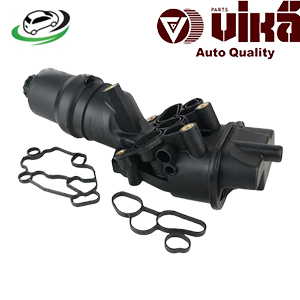-11%
Get Volkswagen Golf R 2.0T Breather Hose 06F103235
The breather hose is a crucial component of a vehicle’s engine ventilation system, responsible for regulating the flow of gases and maintaining the proper pressure within the crankcase. Without proper ventilation, pressure can build up inside the engine, leading to oil leaks, inefficient combustion, and long-term damage to critical engine components. The breather hose provides an outlet for these gases to escape while also ensuring that oil and other contaminants don’t escape with them. In this detailed explanation, we’ll cover the breather hose’s function, benefits, common problems, and maintenance practices.
1. What is a Breather Hose?
A breather hose is part of the Positive Crankcase Ventilation (PCV) system in modern internal combustion engines. It connects the crankcase to the intake manifold or air intake system, allowing gases that build up in the crankcase to be routed back into the combustion chamber for re-burning. This process reduces emissions and prevents the buildup of pressure in the engine.
The breather hose is usually made of durable rubber or silicone, capable of withstanding high temperatures and exposure to oil vapors. The hose ensures a one-way flow of gases out of the crankcase, sometimes using valves to control the direction of flow.
2. Functions of the Breather Hose
The breather hose plays a significant role in maintaining engine health and performance. Below are its key functions:
- Releasing Crankcase Pressure: During the combustion process, a small amount of gases, known as blow-by gases, escape past the piston rings and accumulate in the crankcase. If these gases are not properly ventilated, they can increase pressure in the crankcase, leading to oil leaks and damaging seals. The breather hose provides an escape route for these gases, ensuring that crankcase pressure remains within safe limits.
- Preventing Oil Contamination: The breather hose helps prevent contaminants from mixing with the engine oil. Blow-by gases contain unburned fuel, water vapor, and combustion by-products that can degrade the quality of the oil. The breather system separates these gases, routing them back to the intake manifold for combustion and preventing contamination of the engine oil.
- Reducing Emissions: The breather hose is an essential part of the vehicle’s emission control system. By routing blow-by gases back into the engine to be burned again, it prevents these harmful gases from escaping into the atmosphere. This helps reduce hydrocarbon emissions and ensures compliance with environmental regulations.
- Ensuring Efficient Combustion: Proper ventilation of the crankcase ensures that the engine operates efficiently. Without a breather hose, pressure buildup could interfere with the normal operation of the engine, leading to incomplete combustion, reduced power output, and increased fuel consumption.
3. Benefits of a Properly Functioning Breather Hose
A properly functioning breather hose offers several benefits for both the engine and the overall performance of the vehicle. These include:
- Maintains Optimal Engine Pressure: By releasing excess crankcase pressure, the breather hose ensures that the engine operates within the proper pressure range. This helps prevent damage to seals, gaskets, and other components that could be caused by excessive pressure.
- Prevents Oil Leaks: Excess pressure in the crankcase can force oil past seals and gaskets, leading to oil leaks. The breather hose reduces this pressure, helping to prevent leaks and keeping the engine compartment clean.
- Improves Engine Longevity: By ensuring proper ventilation and preventing oil contamination, the breather hose helps extend the life of the engine. Clean oil and consistent pressure reduce wear on internal components, allowing the engine to perform efficiently over a longer period.
- Reduces Harmful Emissions: The breather hose plays a vital role in reducing the release of harmful gases into the environment. By routing blow-by gases back into the engine for combustion, the hose helps decrease the vehicle’s overall emissions and minimizes its environmental impact.
- Enhances Fuel Efficiency: An engine with a well-maintained breather hose operates more efficiently, as proper ventilation ensures that the air-fuel mixture in the combustion chamber is not compromised. This leads to more complete combustion and better fuel efficiency.
- Prevents Sludge Buildup: Blow-by gases contain moisture and fuel vapors, which can contribute to sludge buildup in the engine. Sludge can clog oil passages, reducing oil flow and leading to engine damage. A functioning breather hose prevents these gases from contaminating the oil, reducing the risk of sludge formation.
4. Common Problems with Breather Hoses
Breather hoses, like other engine components, can wear out over time or develop problems due to exposure to heat, oil, and contaminants. Some common issues with breather hoses include:
- Cracks or Leaks: Over time, the rubber or silicone material of the breather hose can deteriorate due to exposure to heat, oil, and environmental factors. This can cause the hose to crack or develop leaks, which reduces its ability to vent gases effectively and can lead to pressure buildup in the crankcase.
- Clogged Hose: A breather hose can become clogged with oil deposits, dirt, or carbon buildup over time. A clogged hose will restrict the flow of gases, leading to increased pressure in the crankcase and possibly causing oil leaks or reduced engine performance.
- Collapsed Hose: In some cases, the breather hose may collapse due to vacuum pressure or a weak hose structure. A collapsed hose will restrict airflow, leading to improper ventilation of the crankcase and potentially causing engine issues like stalling or rough idling.
- Faulty PCV Valve: Many breather systems include a one-way PCV valve that regulates the flow of gases between the crankcase and the intake manifold. If the valve becomes stuck or fails, it can either prevent gases from venting properly or allow oil to be sucked into the intake system, leading to oil consumption and poor engine performance.
5. Symptoms of a Failing Breather Hose
If the breather hose is malfunctioning, several symptoms may indicate a problem. These include:
- Oil Leaks: If the breather hose is clogged or cracked, excess pressure can build up in the crankcase, causing oil to leak from seals and gaskets. This may result in visible oil leaks on the engine or under the vehicle.
- Rough Idling or Stalling: A blocked or damaged breather hose can disrupt the air-fuel mixture, leading to rough idling or even engine stalling. This happens because the engine may receive too much or too little air, affecting combustion.
- Excessive Oil Consumption: If the breather hose is damaged or the PCV valve is faulty, oil may be sucked into the intake manifold and burned along with the air-fuel mixture. This leads to increased oil consumption and blue smoke from the exhaust.
- Poor Engine Performance: A malfunctioning breather hose can cause the engine to run poorly, with symptoms such as decreased power, hesitation, and poor acceleration. This is often due to improper ventilation, which affects the engine’s ability to maintain consistent pressure.
- Check Engine Light: In modern vehicles, a faulty breather hose or PCV valve can trigger the Check Engine Light. This may occur because the engine control unit (ECU) detects an imbalance in the air-fuel ratio or other issues related to crankcase ventilation.
6. Maintenance and Replacement of Breather Hoses
Maintaining the breather hose is essential to ensure proper engine ventilation and prevent long-term damage. Here are some tips for maintaining and replacing breather hoses:
- Regular Inspections: During routine vehicle maintenance, inspect the breather hose for signs of wear, such as cracks, leaks, or soft spots. If any damage is found, replace the hose immediately to prevent further issues.
- Clean the Breather Hose: Over time, oil and dirt can accumulate inside the breather hose, restricting airflow. Cleaning the hose with an appropriate solvent can help remove these deposits and restore proper ventilation.
- Check the PCV Valve: If the breather hose system includes a PCV valve, inspect it regularly to ensure it’s functioning correctly. A faulty PCV valve can cause issues with the breather hose and the overall ventilation system.
- Replace Worn-Out Hoses: Breather hoses are subject to wear and tear due to exposure to engine heat, oil, and contaminants. It’s recommended to replace the breather hose every few years, or as specified by the vehicle’s manufacturer, to ensure proper engine function.
- Use Quality Replacement Parts: When replacing the breather hose, use high-quality OEM or aftermarket parts that are designed for your specific vehicle model. This ensures a proper fit and reliable performance.
7. Conclusion
The breather hose is a small but vital component of an engine’s ventilation system, responsible for regulating crankcase pressure and preventing oil contamination. A well-functioning breather hose improves engine performance, reduces emissions, and extends the life of the engine by ensuring proper ventilation. Regular inspection, cleaning, and timely replacement of the breather hose are essential maintenance practices that will help keep the engine running smoothly and efficiently over time.
Follow us on Facebook for more parts.




Reviews
Clear filtersThere are no reviews yet.